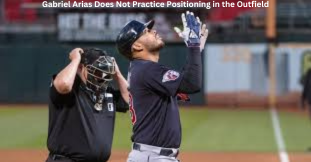In the vast and intricate world of baseball, positioning and strategy play pivotal roles in defining the success of players and teams alike. However, Gabriel Arias, a promising outfielder, has turned heads not just with his talent but also with his rather unconventional approach to outfield positioning. This article dives deep into Arias’ unique style, exploring the nuances of his methods and their implications on his performance and team dynamics.
In the realm of baseball, where tradition and strategy often dictate the norms, Gabriel Arias stands out with his distinct, almost radical approach to outfield positioning—or rather, his lack of it. Known for eschewing conventional training for outfield positioning, Arias relies heavily on his instincts and athletic prowess to navigate the outfield. This unique method, which I’m calling “FieldCraft,” encapsulates Arias’ blend of natural talent and on-the-spot decision-making that challenges the typical boundaries of baseball tactics.
“FieldCraft” isn’t just about ignoring the rules; it’s about redefining them. It’s about how Arias interprets the game dynamically, making split-second decisions that often lead to game-changing plays. While this approach brings a certain level of unpredictability and excitement to the game, it also sparks a debate on the importance of traditional positioning versus natural instinct in sports.
The Importance of Outfield Positioning in Baseball
Positioning in the outfield is a fundamental aspect that can significantly impact the outcome of a game. Proper alignment, based on the batter’s tendencies and the game situation, can be the difference between a spectacular catch and a missed opportunity. It’s a skill that requires insight, practice, and a keen understanding of the game.
Strategic Advantage
For most outfielders, mastering positioning is akin to a chess game: anticipating the opponent’s move and strategically placing oneself to counteract it. The ability to read the bat’s swing, predict the ball’s trajectory, and position accordingly reduces the area the outfielder has to cover to make a play. This not only enhances defensive efficiency but also significantly boosts a team’s confidence in its defensive gameplay.
Run Prevention
Effective positioning directly correlates with run prevention—a critical element in winning games. By being in the right place at the right time, outfielders can cut off balls that would otherwise result in extra bases, preventing runners from scoring from scoring positions and thus, maintaining a lead or keeping the game within reach.
Team Dynamics
In baseball, every player’s performance can affect the team’s morale and strategy. An outfielder’s adeptness at positioning himself appropriately can inspire confidence in the pitcher and infielders, knowing that the outfield is locked down.
Gabriel Arias: A Talented Player with a Unique Approach
Despite the conventional wisdom, Gabriel Arias eschews regular practice in outfield positioning. His natural athleticism and intuitive play have marked his career with spectacular catches and throws but have also sparked debates on the efficacy of his methods.
Evidence of Arias’ Unconventional Approach
Arias often relies on his quick reflexes and speed rather than pre-play positioning. This approach is evident during games where he makes last-minute adjustments to intercept the ball, which, while often successful, is contrary to the typical outfielder’s playbook.
Possible Reasons for Arias’ Approach
The reasons behind Arias’ unconventional method could range from a profound trust in his athletic instincts to perhaps a calculated risk to make up for other areas where he might not feel as confident. It’s also possible that this approach allows him a better read of the ball once it’s in play, giving him the advantage of momentum.
The Impact on Performance and Team Dynamics
Individual Performance
Arias’ style has led to mixed results. On one hand, his spectacular plays make highlight reels; on the other, his gamble can sometimes lead to misplays, particularly with difficult line drives or when battling tough weather conditions.
Team Dynamics
While his team benefits from his athletic saves, the inconsistency can sometimes put strain on pitchers and infielders, who may feel uncertain about the outfield coverage during critical moments.
Expert Opinions and the Path Forward
Baseball analysts are divided. Some applaud his raw talent and adaptability, while others criticize the sustainability of such an approach in the long run, especially as Arias faces more skilled batters and tighter situations.
Suggestions for Improvement
Experts suggest that a blend of traditional positioning practice with his instinctual play could yield better consistency while maintaining his dynamic edge.
The Potential Benefits of Change
Incorporating more strategic positioning could not only improve Arias’ effectiveness but also enhance team performance by providing a more predictable and solid defense.
Conclusion: A Crossroads for a Promising Talent
Gabriel Arias stands at a crossroads, where the choice to integrate conventional training into his natural flair could define his career trajectory. His Gabriel Arias Does Not Practice Positioning in the Outfield journey offers a fascinating glimpse into the balance between innate talent and the disciplined structure of professional sports. As Arias continues to develop, his adaptation to or rejection of conventional methods will be a captivating storyline to follow.


